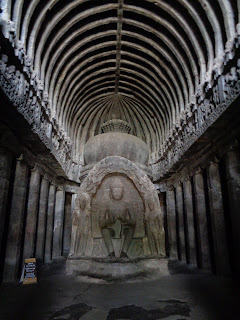IIT-Kharagpur and Mandarmani Beach
 |
| Pre-monsoon rainstorm |
The whole pre-monsoon rainstorm was over in about ten minutes.
It was cool to see just how much rain can come down at once. When the monsoon
comes, it is not consistently as windy as it was during our stop, but it dumps
rain for up to a week at a time. Every year the monsoon is the paramount
concern of farmers in India. The four months of monsoon provide water for a
year’s worth of agriculture. The monsoon is highly variable and difficult to
predict. Professors and grad students at Institutions including IIT-Bombay have
been working on modeling and predicting the monsoon for decades, but it is
inherently difficult to predict because it is affected by weather patterns
worldwide from El Nino in the Atlantic to convection currents in the Bay of
Bengal.
During our visit to IIT-Kharagpur, we heard some guest
lectures about the university, the physics of the monsoon, and the challenge of
making communities resilient to extreme climate events. We also toured the
science and technology museum which had some great hands-on experiments about
mathematical concepts. The building which now houses the museum used to be part
of a prison complex during the British occupation of India.
In the afternoon, we took a quick visit to an agricultural
area near the university where different genetic varieties of tea are grown to taste
test. After the farm, we drove to visit a river. There was no academic plan to
visit the river, so we played cricket on the beach until it became dark.
 |
| Bay of Bengal near Mandarmani Beach |
Back to the conversation about if the bus could reach the
hotel, which I imagine went something like this:
Person A: “There are sharp turns on the one-lane road up
ahead. I don’t know if the bus can make it.”
Person B: “Hmm. I don’t know this road. Should we try to
drive the bus?”
The road was one lane, with some areas we used as makeshift
pullover spots to allow other cars to pass. It took about 20 minutes to go
about 4km because there were many sharp turns and cars coming the in opposite
direction which we needed to pass. Eventually we made it to the hotel and were
very surprised by what we found.
Our resort at Mandarmani Beach looked like it was built in
the 1970s and had not been repainted or repaired since. The statues had
chipping paint and were outdated in style; there was a water park with some
tiny dry slides and a wave pool whose bottom looked green with algae. We
discovered the wave pool not by going swimming, but by taking a ride on the
raised chairlift that spanned the property; we got a bird’s eye view of all
that Sun City Resort had to offer. Instead of being open to the surrounding air
with a safety bar like a ski lift, this attraction had a plastic cover attached
to the safety bar. To sit comfortably in the seat with the bar down, one would
have to be around 5’6”. My head was squished down and my neck kinked for the
slow 15-minute ride across the resort and back. There was only one loading
station, so the chairs served as purely a ride for enjoyment, not
transportation. To top it off, the plastic shield greatly impeded my vision of
the resort because it was yellowed with age.
Despite the state of the resort, the day was great. Swimming
in the Bay of Bengal was fun and the water was warm. After getting about 50
feet out into the water, there was no longer pure sand under my feet. Instead,
there was slippery grey clay lining the bottom of the bay. The slimy clay was a
bit disconcerting before I figured out what I was stepping on.








Comments
Post a Comment